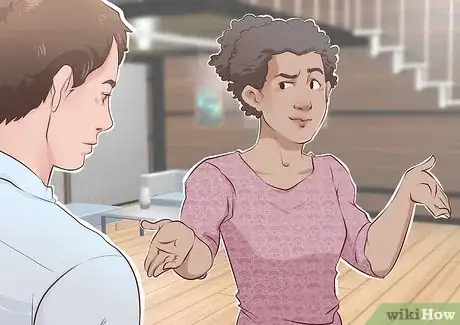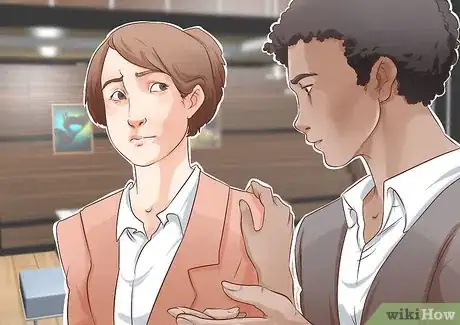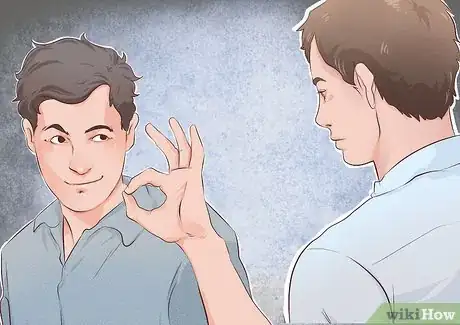This article was co-authored by Lynda Jean. Lynda Jean is an Image Consultant and the Owner of Lynda Jean Image Consulting. With over 15 years of experience, Lynda specializes in color and body/style analysis, wardrobe audits, personal shopping, social and professional etiquette, and personal and business branding. She works with clients to enhance their image, self-esteem, behavior, and communication to facilitate their social and career goals. Lynda holds Bachelor degrees in Sociology and Social Work, a Master’s degree in Clinical Social Work, and a Certified Image Consultant (CIC) certification. She studied Image Consulting at the International Image Institute and the International Academy of Fashion and Technology in Toronto, Canada. Lynda has taught Image Consulting courses at George Brown College in Toronto, Canada. She is the co-author of the book, “Business Success With Ease,” where she shares her knowledge about, ‘The Power of Professional Etiquette.’
There are 9 references cited in this article, which can be found at the bottom of the page.
This article has been viewed 117,901 times.
Having a natural-flowing conversation is a meaningful and rewarding experience. Conversing with friends or family members is enjoyable and may be a useful way to express affection, interest, or concern. Having a conversation with strangers at a party or social event is also a great way to make friends and get to know people. For some people, it may be hard to keep a conversation going beyond the initial introductions. A good conversation may need some work in order to stay strong and avoid those awkward silences, but it's not impossible. With a little preparation, and helpful techniques, you can learn how to have a long and meaningful conversation with just about anyone.
Steps
Having a Meaningful Conversation
-
1Choose a purpose. Every conversation conveys something. If you're going to carry on a conversation with someone you know, it's probably either to tell them something or to ask them something. Before you get too far into the conversation, it may be helpful to know in advance what you intend to talk about.[1]
- Is the purpose of your conversation to apologize? To let someone know that you're upset about something? To talk about an incident that occurred between you and a mutual friend? Each of these conversations will have a drastically different tone, and should be approached with a different conversational agenda.[2]
- You don't need to dictate how the conversation will progress. It's simply helpful to be aware of what your intentions for the conversation are (if you have any) so that you do not have to change gears abruptly.[3]
-
2Know what to say. It's a good idea to plan out important conversations. That way, once you're talking to someone and find a gap in a conversation, you can easily draw on what you've planned in advance. Of course, that doesn't mean planning out the entire conversation. But it can be helpful to have a few basic phrases or topics in mind, like how you intend to open up the conversation and what kinds of questions you might ask to keep it going.[4]
- Planning out the specifics of a conversation will make it feel scripted and forced. Don't plan out everything you're going to say. Instead, just give yourself a basic idea of the kinds of things you'd like to talk about.[5]
Advertisement -
3Acknowledge your surroundings. This works in two ways. First, it may be useful to acknowledge your physical surroundings as a way to keep the conversation going.[6] For example, if you're in a park, you can comment on the scenery if the conversation begins to drag.[7] Second, it's important to be aware of your surroundings and know what's appropriate. For certain conversational topics, like letting someone know about a recent death or other upsetting/unpleasant news, there's a right and wrong time and place.[8]
- Bringing up the wrong thing in the wrong time/place can be a real conversation killer.[9]
- It's important to be aware of your surroundings. It can help or hurt a conversation, and may even dictate the tone and topics of the conversation.
-
4Recognize individuality. You may go into a conversation knowing that your favorite movie/artist/band is the greatest, but not everyone will feel that way. And that's okay - in fact, it's a good thing. Different tastes and opinions will combine to create an interesting dialogue. But the important thing is to be respectful of those differences, and to remember that they exist.[10]
- Not everyone will see/think/feel the way you do. It's imperative that you be aware of this reality, and respect the way others see/think/feel. Nothing will kill a conversation faster than telling someone that they're wrong to think or feel a certain way.[11]
- Try to put yourself in the other person's shoes. It will help keep the conversation going and may help bring you closer to the other person.[12]
-
5Be conscious of your body language. Many people don't think about their own body language, but most people recognize body language cues (both conscious and unconscious) in other people. If you avoid eye contact, turn your body away from the person talking to you, and cross your arms across your body, it conveys a lack of interest or an unwillingness to listen.[13]
- Face the person you're talking with, and make eye contact while you chat.[14]
Being an Active Listener
-
1Listen as much as you speak.[15] Many people inadvertently dominate conversations by doing most of the talking. The key to a real back-and-forth dialogue is to listen attentively to the other person at least as much as you talk.[16]
- Give the other person space to talk, including time to respond to the things that you say.[17]
-
2Wait before responding. If the other person is talking, don't jump in as soon as she finishes speaking. She may be collecting her thoughts, or she may remember something at the last minute that is relevant to what was just being said. As a good general rule, wait one or two seconds after the other person has finished speaking before you respond. It shows that you're interested in what she's said, and it conveys that you want to have a real back-and-forth dialogue.[18]
-
3Acknowledge good ideas. If the person you're speaking with says something you agree with or makes a good point, acknowledge this. Let the person know that you are listening by actively acknowledging the things she says and saying things like, "That's a good point" or "Wow, I hadn't considered that."[19]
-
4Pick up on misunderstandings. During the course of conversation, it's possible that you may be misunderstood from time to time. Part of being an active listener involves listening for uncertainty or misunderstandings in response to something you've said.[20]
- The other person's facial expressions may give some insight into whether or not you've been misunderstood.
- If the person you're conversing with responds to something you've said with a comment or conversational shift that suggests you were misunderstood, it's best to clarify what you meant. That can help avoid awkward or unwanted conversational topics before they arise.
Avoiding Conversation Stalls
-
1Ask open-ended questions. Many conversations fall apart because one of the speakers only asks questions that will elicit a yes or no response. This makes it difficult to keep the dialogue going, and may create conversational anxiety for both people. Instead of simple yes/no questions, ask open-ended questions that will allow for substantial responses.[21]
- Instead of asking, "Did you like the movie?" ask an open-ended question, such as "What stands out to you about the movie?"[22]
-
2Build on what's been said. Don't interject information or topics that haven't been brought up. It's a quick way to make the other person feel like you're not listening or overly focused on your own thoughts. Instead, build off of what's been said by the other person.[23]
- Don't look for opportunities to insert something about yourself. Instead, offer an opinion, and let it lead to a question that follows up what the other person has said.[24]
- Try to follow up a comment with some observation about what's been said.[25] For example, if the other person says that she is originally from Boston, say something like, "I've never been to Boston, but I hear it's a wonderful city. How does it compare to the city you live in now?"
-
3Think before you speak. Many people get caught up in the excitement of a conversation and say the first thing that comes to mind. That may feel right in the moment, but it can easily lead to inadvertent conversation killers. Take a few seconds to think before you speak, and not only will you avoid accidentally offending someone or creating a roadblock in the conversation, you'll probably also come across as more of an eloquent and thoughtful speaker.[26]
-
4Avoid negative words. Saying something negative about what the other person has said can quickly kill the conversation. It often happens in unintended ways, but a negative comment (intentional or not) can make it difficult for the other person to know what to say next.[27]
- Instead of saying something like, "I don't like reading fiction," say what you do like, like "I typically read more nonfiction, like memoirs and essays. Who's your favorite author?"[28]
-
5Stay clear of controversy. If you don't want to end the conversation abruptly, avoid any controversial topics.[29] Two of the quickest conversation killers are politics and religion.[30] If you don't know the other person well enough to be clear on where she stands on controversial topics, or if you know the person and you're aware that she disagrees with you on certain issues, avoid them altogether.[31]
Reviving a Stalled Conversation
-
1
-
2Fall back on common interests.[34] If you and the person you're talking to have things in common or similar tastes/interests, you can fall back on those topics when the conversation stalls. For example, if the person said earlier in the conversation that she really likes comedic movies, and you find yourselves with an awkward pause, say something like, "So you were saying you like comedies. Have you seen any good movies lately?"[35]
-
3Take a breather. Sometimes you may need to step away from a conversation for a moment. If there's a long pause and you can't think of anything to contribute, perhaps excusing yourself for a moment might help jumpstart the conversation when you get back. Excuse yourself politely by saying something like, "Will you excuse me a moment? I need to use the restroom" or "I'm really enjoying this conversation. I just need a drink of water - will you excuse me a moment?"[36] Then use your momentary absence to think of something to talk about when you get back. You may even find something to talk about if you observe something interesting while you're gone - just be sure you don't come back with gossip.[37]
-
4Know when the conversation is over. Sometimes you can restart a stalled conversation, but eventually the conversation must draw to a close. If it's a strenuous conversation to keep going, that may be all the more reason to find a smooth conclusion to the conversation. If things simply can't be restarted, or if you believe you've already exhausted the conversation, end it politely and respectfully by saying something like, "Well it was really good talking to you. I learned a lot about _____! Thank you for listening, and I hope we can continue this conversation another time."[38]
Expert Q&A
Did you know you can get expert answers for this article?
Unlock expert answers by supporting wikiHow
-
QuestionHow do I keep a conversation going when I have nothing to say?
 Lynda JeanLynda Jean is an Image Consultant and the Owner of Lynda Jean Image Consulting. With over 15 years of experience, Lynda specializes in color and body/style analysis, wardrobe audits, personal shopping, social and professional etiquette, and personal and business branding. She works with clients to enhance their image, self-esteem, behavior, and communication to facilitate their social and career goals. Lynda holds Bachelor degrees in Sociology and Social Work, a Master’s degree in Clinical Social Work, and a Certified Image Consultant (CIC) certification. She studied Image Consulting at the International Image Institute and the International Academy of Fashion and Technology in Toronto, Canada. Lynda has taught Image Consulting courses at George Brown College in Toronto, Canada. She is the co-author of the book, “Business Success With Ease,” where she shares her knowledge about, ‘The Power of Professional Etiquette.’
Lynda JeanLynda Jean is an Image Consultant and the Owner of Lynda Jean Image Consulting. With over 15 years of experience, Lynda specializes in color and body/style analysis, wardrobe audits, personal shopping, social and professional etiquette, and personal and business branding. She works with clients to enhance their image, self-esteem, behavior, and communication to facilitate their social and career goals. Lynda holds Bachelor degrees in Sociology and Social Work, a Master’s degree in Clinical Social Work, and a Certified Image Consultant (CIC) certification. She studied Image Consulting at the International Image Institute and the International Academy of Fashion and Technology in Toronto, Canada. Lynda has taught Image Consulting courses at George Brown College in Toronto, Canada. She is the co-author of the book, “Business Success With Ease,” where she shares her knowledge about, ‘The Power of Professional Etiquette.’
Certified Image Consultant
-
QuestionWhat about when I'm midway into a conversation?
 Community AnswerIf you want to continue a conversation, start asking questions about them. If you already did that, tell them a story, or more about yourself.
Community AnswerIf you want to continue a conversation, start asking questions about them. If you already did that, tell them a story, or more about yourself.
References
- ↑ https://www.psychologytoday.com/blog/friendship-20/201509/7-ways-make-your-most-difficult-conversations-easier
- ↑ https://www.psychologytoday.com/blog/friendship-20/201509/7-ways-make-your-most-difficult-conversations-easier
- ↑ https://www.psychologytoday.com/blog/friendship-20/201509/7-ways-make-your-most-difficult-conversations-easier
- ↑ https://www.psychologytoday.com/blog/friendship-20/201509/7-ways-make-your-most-difficult-conversations-easier
- ↑ https://www.psychologytoday.com/blog/friendship-20/201509/7-ways-make-your-most-difficult-conversations-easier
- ↑ Lynda Jean. Certified Image Consultant. Expert Interview. 17 November 2020.
- ↑ https://www.psychologytoday.com/blog/in-practice/201312/21-first-date-ideas
- ↑ https://www.psychologytoday.com/blog/friendship-20/201509/7-ways-make-your-most-difficult-conversations-easier
- ↑ https://www.psychologytoday.com/blog/friendship-20/201509/7-ways-make-your-most-difficult-conversations-easier
- ↑ https://www.psychologytoday.com/blog/conversational-intelligence/201410/conversational-blind-spots-0
- ↑ https://www.psychologytoday.com/blog/conversational-intelligence/201410/conversational-blind-spots-0
- ↑ https://www.psychologytoday.com/blog/conversational-intelligence/201410/conversational-blind-spots-0
- ↑ https://www.psychologytoday.com/blog/friendship-20/201509/7-ways-make-your-most-difficult-conversations-easier
- ↑ https://www.psychologytoday.com/blog/friendship-20/201509/7-ways-make-your-most-difficult-conversations-easier
- ↑ Lynda Jean. Certified Image Consultant. Expert Interview. 17 November 2020.
- ↑ https://www.psychologytoday.com/blog/friendship-20/201509/7-ways-make-your-most-difficult-conversations-easier
- ↑ https://www.psychologytoday.com/blog/friendship-20/201509/7-ways-make-your-most-difficult-conversations-easier
- ↑ https://www.psychologytoday.com/blog/how-do-life/201509/three-keys-effective-conversation
- ↑ https://www.psychologytoday.com/blog/conversational-intelligence/201502/quality-conversations
- ↑ https://www.psychologytoday.com/blog/what-mentally-strong-people-dont-do/201510/8-ways-survive-awkward-conversations
- ↑ https://www.psychologytoday.com/blog/resolution-not-conflict/201507/how-good-are-you-the-art-conversation-quiz
- ↑ https://www.psychologytoday.com/blog/resolution-not-conflict/201507/how-good-are-you-the-art-conversation-quiz
- ↑ https://www.psychologytoday.com/blog/resolution-not-conflict/201507/how-good-are-you-the-art-conversation-quiz
- ↑ https://www.psychologytoday.com/blog/resolution-not-conflict/201507/how-good-are-you-the-art-conversation-quiz
- ↑ https://www.psychologytoday.com/blog/resolution-not-conflict/201507/how-good-are-you-the-art-conversation-quiz
- ↑ https://www.psychologytoday.com/blog/creating-in-flow/201502/5-fixes-conversations-go-bad
- ↑ https://www.psychologytoday.com/blog/resolution-not-conflict/201507/how-good-are-you-the-art-conversation-quiz
- ↑ https://www.psychologytoday.com/blog/resolution-not-conflict/201507/how-good-are-you-the-art-conversation-quiz
- ↑ Lynda Jean. Certified Image Consultant. Expert Interview. 17 November 2020.
- ↑ https://www.psychologytoday.com/blog/conversational-intelligence/201502/quality-conversations
- ↑ https://www.psychologytoday.com/blog/conversational-intelligence/201502/quality-conversations
- ↑ Lynda Jean. Certified Image Consultant. Expert Interview. 17 November 2020.
- ↑ https://www.psychologytoday.com/blog/conversational-intelligence/201410/conversational-blind-spots-0
- ↑ Lynda Jean. Certified Image Consultant. Expert Interview. 17 November 2020.
- ↑ https://www.psychologytoday.com/blog/resolution-not-conflict/201507/how-good-are-you-the-art-conversation-quiz
- ↑ https://www.psychologytoday.com/blog/creating-in-flow/201502/5-fixes-conversations-go-bad
- ↑ https://www.psychologytoday.com/blog/creating-in-flow/201502/5-fixes-conversations-go-bad
- ↑ https://www.psychologytoday.com/blog/what-mentally-strong-people-dont-do/201510/8-ways-survive-awkward-conversations























-Step-11.webp)























































